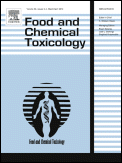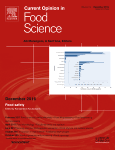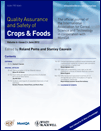
World Mycotoxin Journal
Scope & Guideline
Innovating solutions for mycotoxin-related health risks.
Introduction
Aims and Scopes
- Mycotoxin Detection and Analysis:
Focuses on developing and refining analytical techniques for the detection and quantification of mycotoxins in food and feed, including innovative methods such as nanoparticle-based assays and spectroscopy. - Health Impacts of Mycotoxins:
Investigates the toxicological effects of mycotoxins on human and animal health, including studies on exposure levels, biomonitoring, and interaction with biological systems. - Prevention and Mitigation Strategies:
Explores agricultural and technological interventions to reduce mycotoxin contamination, such as biocontrol methods, post-harvest management, and food processing techniques. - Occurrence and Risk Assessment:
Examines the prevalence of mycotoxins in various crops and food products, assessing agronomic factors that contribute to contamination and the associated health risks. - Socioeconomic Implications:
Analyzes the economic impact of mycotoxin contamination on food security, trade, and farmer livelihoods, particularly in developing regions.
Trending and Emerging
- Multi-Mycotoxin Research:
A growing trend towards studying multiple mycotoxins simultaneously, acknowledging that food products often contain various contaminants that can have cumulative health effects. - Biodegradation and Biocontrol Methods:
Increased focus on biological methods for mycotoxin reduction, including the use of probiotics, natural extracts, and microbial solutions to mitigate contamination. - Technological Innovations in Detection:
Emerging research on advanced detection techniques such as smartphone-based technologies and mass spectrometry, which enhance the ability to monitor mycotoxin levels effectively. - Impact of Climate Change on Mycotoxin Production:
Research is increasingly addressing how climate change and abiotic factors influence the growth of mycotoxin-producing fungi and the subsequent risk of contamination. - Public Health and Policy Implications:
A trend towards linking mycotoxin research with public health outcomes and the development of policies aimed at mitigating risks, particularly in vulnerable populations.
Declining or Waning
- Historical Reviews and General Overviews:
There has been a noticeable decrease in papers focusing on broad historical reviews or general overviews of mycotoxin issues, as the journal shifts towards more specific and actionable research. - Traditional Agricultural Practices:
Research centered on conventional agricultural practices and their relationship with mycotoxin contamination appears to be declining, as newer studies emphasize innovative and integrated management strategies. - Single Mycotoxin Studies:
There is a waning interest in studies that focus exclusively on single mycotoxins, with a growing preference for multi-mycotoxin analyses that reflect the complex interactions and cumulative effects in food systems.
Similar Journals

JOURNAL OF ANALYTICAL CHEMISTRY
Innovating Insights in Analytical ChemistryJOURNAL OF ANALYTICAL CHEMISTRY, published by PLEIADES PUBLISHING INC, stands as a pivotal resource in the field of analytical chemistry, offering an innovative platform for researchers, professionals, and students to advance their knowledge and contribute to the discourse within the discipline. With an ISSN of 1061-9348 and an E-ISSN of 1608-3199, this journal features a focused exploration of analytical methodologies, instrumentation developments, and applications across various domains, contributing to practical and theoretical advancements in the field. Currently ranked in the Q3 category in Analytical Chemistry with a Scopus rank of #111 out of 156, it provides critical insights and innovation strategies for professionals aiming to enhance their analytical capabilities. Access to the journal is through standard subscription models, and it covers an extensive range of topics pertinent to the discipline from 1996 to 2024. Engage with the JOURNAL OF ANALYTICAL CHEMISTRY to be part of a vibrant research community dedicated to push the boundaries of analytical practices.

Mycotoxin Research
Mitigating Risks Through Interdisciplinary ResearchMycotoxin Research, published by Springer Heidelberg, is a vital interdisciplinary journal dedicated to the exploration and study of mycotoxins, their impacts on health and environment, as well as strategies for mitigation. With a solid presence in the fields of Biotechnology, Microbiology, and Toxicology, it has earned a respectable Q3 ranking and continues to facilitate the dissemination of impactful research from 1985 through to 2024. The journal caters to a diverse audience, including researchers, professionals, and students, providing a platform for original research articles, reviews, and case studies that contribute to the understanding and management of mycotoxins. Although it does not offer open-access options, the journal remains a critical resource, engaging its readers with cutting-edge findings and advancements that shape the future of health and safety regarding mycotoxin exposure. With Scopus rankings reflecting its relevance—44th in Toxicology, 113th in Biotechnology, and 71st in Microbiology—Mycotoxin Research stands as an essential publication for anyone dedicated to advancing knowledge in these critical scientific domains.

FOOD AND CHEMICAL TOXICOLOGY
Championing research that protects consumers and environments.FOOD AND CHEMICAL TOXICOLOGY, published by Pergamon-Elsevier Science Ltd, is a prestigious journal with a significant impact in the fields of food science, medicine, and toxicology, reflecting its Q1 and Q2 quartile rankings in various categories as of 2023. Established in 1982, this journal continues to serve as an essential platform for disseminating high-quality research focused on the toxicological assessment of foods and chemicals, aiming to advance knowledge that affects public health and safety. With a pivotal role in integrating diverse disciplines, including pharmacology and agricultural sciences, the journal ranks impressively within the top percentiles—specifically 95th in Toxicology and 92nd in Food Science on the Scopus metrics. Though it operates on a traditional subscription model, the journal is committed to providing valuable insights and findings to researchers, professionals, and students across the globe, making it a vital resource in the ongoing discourse around food safety and environmental health. Its comprehensive scope underscores its importance in shaping evidence-based policies and practices.

JOURNAL OF PESTICIDE SCIENCE
Empowering research for a healthier planet.JOURNAL OF PESTICIDE SCIENCE, published by the PESTICIDE SCI SOC JAPAN, serves as a crucial conduit for scientific discourse in the fields of pesticide science, toxicology, and insect science. Since its inception in 1975 and now an Open Access journal since 2020, it aims to disseminate high-quality research findings, reviews, and innovative methods, directly supporting advancements in both agricultural sustainability and public health. With an ISSN of 1348-589X, the journal currently holds a Q3 ranking for Health, Toxicology and Mutagenesis, and a commendable Q2 rank in Insect Science—a testament to its relevance and impact within the scientific community. As of 2023, it is recognized in Scopus with notable rankings in various categories, emphasizing its significance among peers. The journal is headquartered at TOKYO UNIV AGR DEPT OF AGR CHEM, TOKYO, JAPAN, and remains committed to fostering collaboration and promoting vital research that addresses the challenges posed by pesticide use. Researchers, professionals, and students alike are encouraged to engage with this essential resource, contributing to the ongoing dialogue regarding pest management and environmental health.

Food Analytical Methods
Transforming the future of food safety and quality analysis.Food Analytical Methods, published by Springer, is an esteemed journal dedicated to the innovative field of analytical methodologies within the food sciences. With an ISSN of 1936-9751 and E-ISSN of 1936-976X, this journal serves as a pivotal platform for researchers and professionals to exchange insights, methodologies, and findings related to food quality analysis, safety measures, and innovative technologies in food science. As of 2023, Food Analytical Methods boasts impressive Scopus rankings, including Q2 in Analytical Chemistry and Food Science, positioning it among the top journals in its category. The journal's commitment to enhancing food safety and quality through rigorous research underscores its importance in both academic and industrial applications. Although it does not currently operate under an open-access model, it provides exceptional value through its rigorous peer-review process and comprehensive publication standards, further inviting contributions from both established and emerging scientists in the field. With coverage spanning from 2008 to 2024, this journal continues to address critical research areas, thereby shaping the future of food analytics.

Current Opinion in Food Science
Transforming Food Science Through Critical DialogueCurrent Opinion in Food Science is a premier peer-reviewed journal published by ELSEVIER SCI LTD that focuses on the latest advancements and research in the domain of food science and technology. With its ISSN 2214-7993 and E-ISSN 2214-8000, this journal serves as a critical platform for researchers and professionals to share insights and opinions on emerging trends, innovations, and challenges faced in food science. The journal enjoys an impressive impact factor and ranks in the first quartile (Q1) in both Applied Microbiology and Biotechnology and Food Science, symbolizing its influence and reputation in the field. It is strategically located in the Netherlands and conducts its academic dialogue with a broad scope that includes essential topics in food safety, nutrition, and sustainable practices. Operating from 2015 to 2024, the journal has established itself as a critical resource for the global academic community, boasting excellent Scopus rankings—#9 out of 389 in Food Science and #6 out of 127 in Applied Microbiology and Biotechnology—indicating its high relevance and impact. Readers can look forward to insightful articles and comprehensive reviews that bridge the gap between fundamental research and practical application in the ever-evolving food science landscape.

Quality Assurance and Safety of Crops & Foods
Ensuring excellence in crops and food safety.Quality Assurance and Safety of Crops & Foods is a leading peer-reviewed journal, published by CODON PUBLICATIONS, dedicated to advancing the fields of Agronomy and Crop Science and Food Science. Since its inception in 2009, this journal has established itself as a crucial platform for researchers, professionals, and students, focusing on the vital intersection of agricultural safety and food quality. With a commendable impact factor and a current Scopus ranking placing it in the top quartiles of its field (Q2 in 2023), it serves as an essential resource for those committed to ensuring the safety and quality of global food supplies. The journal provides open access options to enhance the dissemination and accessibility of research findings, thus fostering collaborative efforts to tackle contemporary challenges in food production and safety. By showcasing innovative methodologies and cutting-edge research, Quality Assurance and Safety of Crops & Foods not only contributes to scientific discourse but also plays a pivotal role in informing policy and practice in sustainable agricultural practices.

BULLETIN OF ENVIRONMENTAL CONTAMINATION AND TOXICOLOGY
Connecting science and policy for a sustainable future.BULLETIN OF ENVIRONMENTAL CONTAMINATION AND TOXICOLOGY, published by SPRINGER, is a pivotal journal in the fields of Environmental Science, Toxicology, and Public Health. With a strong history of dissemination since its inception in 1966, the journal predominantly focuses on the latest advances in understanding environmental contaminants and their toxicological effects on health and ecosystems. It currently holds a respectable Q2 ranking across multiple categories including Health, Toxicology and Mutagenesis, Medicine (miscellaneous), and Pollution, as per the 2023 metrics. While the journal is not Open Access, it provides an invaluable platform for researchers, professionals, and students seeking to contribute to and stay informed on critical issues regarding environmental hazards and their implications. With an engaged community of scholars and practitioners, this journal continues to be an essential resource for addressing the pressing challenges of environmental contamination and its health impacts, guiding future research and policy decisions.

Food Production Processing and Nutrition
Transforming food systems for public health excellence.Food Production Processing and Nutrition, published by SpringerNature, stands at the forefront of advancing knowledge in the vibrant fields of food science, nutrition, and public health. This esteemed Open Access journal, operational since 2019, plays a pivotal role in disseminating breakthrough research that intersects food production processes with nutritional insights, making it an invaluable resource for researchers, professionals, and students alike. With a commendable 2023 impact factor reflecting its robust scholarly contributions — Q1 in Food Science and Q2 in both Nutrition and Dietetics and Public Health, Environmental and Occupational Health — the journal not only emphasizes the importance of innovative food processing methods but also addresses pressing nutritional challenges faced globally. Located in the United Kingdom, it claims an impressive Scopus ranking, with a notable percentile standing across various categorical metrics. As such, Food Production Processing and Nutrition is essential for anyone aiming to deepen their understanding of how food systems impact public health through effective processing and nutritional strategies.

JOURNAL OF FOOD PROTECTION
Innovating solutions for food quality and safety.JOURNAL OF FOOD PROTECTION is a prominent academic journal published by Elsevier, dedicated to the field of Food Science and Microbiology. With an ISSN of 0362-028X and an E-ISSN of 1944-9097, it serves as a vital resource for researchers, professionals, and students interested in the microbiological aspects of food safety and quality. Since its inception, the journal has evolved significantly, with coverage spanning from 1977 to the present, reflecting its long-standing commitment to advancing knowledge in this critical area. Recognized for its rigorous peer-reviewed research, the journal boasts a commendable impact factor and ranks in the second quartile in Food Science and the third quartile in Microbiology according to 2023 assessments. Its Scopus ranking also highlights its relevance, with significant placements in both Agricultural and Biological Sciences and Immunology and Microbiology. The JOURNAL OF FOOD PROTECTION is an essential platform for disseminating pioneering studies that address contemporary challenges facing the food industry and public health, making it an indispensable resource in the quest for food safety and innovation.